Professional Curtain Cleaning in London | Avoid Shrinkage, Fading & Wrinkles
Curtain Washing Problems — Advanced Analysis and Preventive Methods
Curtains play an integral role in both aesthetic and functional interior design. Beyond providing privacy and controlling light, they contribute significantly to the visual harmony and thermal balance of indoor spaces. However, maintaining these textiles—particularly the cleaning process—poses considerable challenges. Improper washing can result in shrinkage, colour degradation, distortion, and structural damage. This paper-style guide analyses the underlying causes of these issues and presents evidence-based prevention and care strategies derived from professional textile-cleaning practices at London Dry Cleaning Company.
For the best results, consider seeking out professional services for Professional Curtain Cleaning in London. This not only enhances the longevity of your curtains but also ensures that they maintain their aesthetic appeal.
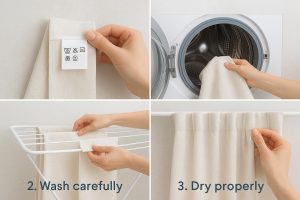 1. Fabric Shrinkage: Thermal and Mechanical Causes
1. Fabric Shrinkage: Thermal and Mechanical Causes
Shrinkage is among the most prevalent and least reversible issues encountered in curtain maintenance, and its root cause lies deep in the morphology of fibres and the thermodynamics of polymer behaviour. When hydrophilic natural fibres—such as cotton, linen, or viscose—are exposed to moisture and heat, they undergo a relaxation process where internal tension, set during weaving and finishing, is released. This process leads to the contraction of polymer chains and a measurable reduction in fabric dimensions.
In more technical terms, shrinkage can occur through multiple mechanisms: relaxation shrinkage (the release of strain from manufacturing), felting shrinkage (common in wool due to fibre-scale interlocking), and consolidation shrinkage (where repeated washing compresses yarn spacing). Each mechanism interacts with fibre type, weave density, and finishing chemistry. Temperature and mechanical agitation accelerate the reconfiguration of hydrogen bonds between cellulose molecules, leading to irreversible shortening. In cotton, the amorphous regions of cellulose absorb water, swell, and then contract as the moisture evaporates, causing the entire structure to draw inward.
Environmental humidity and improper storage conditions can further exacerbate the risk of shrinkage. For instance, curtains stored near heat sources or exposed to variable humidity may experience gradual dimensional instability even before they are washed.
Preventive Measures:
-
Employ cold or lukewarm water during washing to minimise fibre relaxation and thermal contraction.
Utilising professional curtain cleaning services in London can significantly reduce the risk of damage to your curtains during washing.
-
Select mild, pH-neutral detergents to avoid fibre swelling caused by alkaline surfactants.
-
Avoid mechanical stress—low-spin or hand-wash cycles are preferable for delicate fabrics.
-
Eliminate high-temperature tumble drying; instead, opt for air drying in controlled humidity and moderate airflow to maintain fibre equilibrium.
-
Use professional solvent-based cleaning, where non-aqueous systems maintain the fibre’s internal hydrogen-bond matrix and prevent dimensional change.
Choosing Professional Curtain Cleaning in London facilities will help maintain the original structure and appearance of your curtains.
-
For heritage or lined drapery, request fibre-specific pre-treatment testing to determine residual shrinkage potential before cleaning.
At London Dry Cleaning Company, temperature-controlled solvent immersion, precision drum rotation, and humidity-regulated drying ensure dimensional stability across all curtain types. Our process integrates fibre diagnostics, infrared temperature mapping, and post-cleaning measurement verification, guaranteeing no more than ±1% dimensional variation, even in complex, multi-layered drapery systems.
At London Dry Cleaning Company, we offer professional curtain cleaning in London, ensuring the highest standards of care and attention.
2. Structural Deformation and Loss of Rigidity
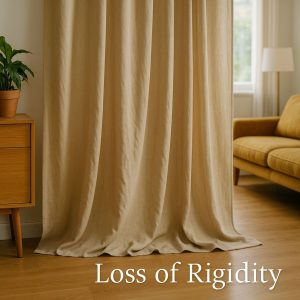 Engaging with Professional Curtain Cleaning in London can prevent costly repairs and replacements for your curtains.
Engaging with Professional Curtain Cleaning in London can prevent costly repairs and replacements for your curtains.
Curtain drape and rigidity are governed by an intricate interplay between fibre composition, yarn twist, weave density, and applied finishing agents such as resins, acrylic polymers, or starch-based coatings. Each of these parameters contributes to the curtain’s tactile response—its crisp hand, body, and hang. When curtains undergo excessive mechanical action or prolonged exposure to alkaline detergents, the protective finishing layer breaks down. This degradation alters the fabric’s modulus of elasticity, causing a permanent loss of rigidity and resulting in limpness and irregular drape formation.
In woven polyester-cotton blends, structural deformation often occurs when surfactants penetrate resin finishes, dislodging the crosslinking agents that provide stiffness. Natural fibres, such as linen, meanwhile, lose rigidity due to the relaxation of the cellulosic chains and the removal of sizing materials applied during the manufacturing process. Repeated laundering accelerates this deterioration, producing uneven stress distribution and fabric buckling. Furthermore, thermal shock during drying can distort synthetic polymers, thereby reducing their shape-memory characteristics.
The physics of drape involves both gravitational and internal forces. Once internal friction between yarns decreases, the curtain collapses under its own weight, compromising aesthetic appearance and function. Professional restorers analyse the material’s flexural rigidity using empirical measurements to determine optimal re-stiffening formulations. By combining thermomechanical finishing with controlled humidity, the original dimensional geometry can be restored.
Preventive Measures:
To avoid distortions, consider Professional Curtain Cleaning in London to ensure your curtains remain in peak condition.
-
Maintain low mechanical agitation to preserve the microstructure and molecular alignment of the yarn.
-
Apply starch, resin, or polymer-based stiffening sprays post-cleaning to reintroduce structural integrity.
-
Dry the curtains while they are slightly damp, allowing the fibres to relax uniformly under gravity, thus preventing distortion of the pleats and hems.
-
Utilise professional re-finishing through calibrated steam and controlled tension systems, which accurately realign fibres and restore the curtain’s original dimensional stability, lustre, and aesthetic symmetry.
-
For high-end drapery, request formulation-matched finishing agents that have been tested for compatibility with specific fibre compositions to avoid yellowing or residue buildup.
3. Crease Retention and Wrinkle Resistance
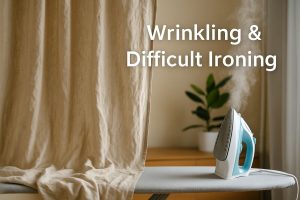 High-mass textiles—such as velvet, brocade, or interlined curtains—are prone to persistent wrinkling due to compression set during washing and drying. This phenomenon arises when internal polymer chains within fibres are plastically deformed under combined pressure and moisture, resulting in permanent structural displacement. Once the glass transition temperature (Tg) of the fibre is surpassed, molecular realignment occurs, locking the distorted configuration in place. Home ironing typically fails to reverse these molecular changes because domestic equipment cannot generate sufficient thermal and moisture penetration to achieve full chain mobility.
High-mass textiles—such as velvet, brocade, or interlined curtains—are prone to persistent wrinkling due to compression set during washing and drying. This phenomenon arises when internal polymer chains within fibres are plastically deformed under combined pressure and moisture, resulting in permanent structural displacement. Once the glass transition temperature (Tg) of the fibre is surpassed, molecular realignment occurs, locking the distorted configuration in place. Home ironing typically fails to reverse these molecular changes because domestic equipment cannot generate sufficient thermal and moisture penetration to achieve full chain mobility.
Implementing Professional Curtain Cleaning in London effectively handles the issue of crease retention.
Wrinkle formation also depends on the fabric’s viscoelastic properties. Materials with high amorphous content, such as rayon and cotton blends, exhibit more pronounced creasing since their molecular regions are less crystalline and therefore more mobile under mechanical stress. Conversely, synthetic fibres with thermoplastic properties (like polyester) may develop glossy patches—known as glazing—if ironed at inappropriate temperatures.
Professional textile engineers address this by combining controlled heat, moisture, and tension to achieve optimal results. During pressing, steam acts as a plasticising agent, temporarily lowering the Tg, which allows for molecular reorientation without fibre damage. Controlled cooling then re-establishes hydrogen bonds in the desired configuration, restoring the curtain’s original smooth appearance.
Preventive Measures:
-
Immediate post-wash hanging prevents creasing by utilising gravitational tension to counteract fibre relaxation and compression set.
-
Utilise vertical steaming and tension frames to facilitate in situ fibre recovery without mechanical abrasion.
-
Prefer steam-based pressing rather than direct-contact ironing to avoid pile flattening, fibre glazing, or localised scorching.
Professional services, such as Professional Curtain Cleaning in London, ensure meticulous care for high-mass textiles.
-
For velvets and pile fabrics, use a vacuum-steam finishing system that lifts pile and restores surface uniformity.
-
Professional steam-finishing systems, such as those used at our Hampstead facility, generate uniform heat, moisture, and mechanical stretching, achieving optimal wrinkle recovery and long-term dimensional stability. They also integrate humidity sensors and pressure regulators to maintain precise moisture equilibrium during finishing.
4. Mechanical Damage: Snags, Pulls, and Abrasions
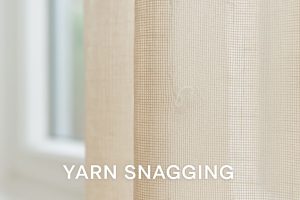 Delicate materials—lace, voile, or jacquard—exhibit low tensile strength and are highly susceptible to mechanical stress during agitation. Snags occur when loops or threads catch on rough surfaces, zippers, or machine components. In textile engineering terms, these damages result from frictional forces and point loading beyond the fabric’s yield threshold. When localised stress exceeds the cohesive strength of the yarn, filament rupture or yarn displacement occurs, leading to visible snags and pulls.
Delicate materials—lace, voile, or jacquard—exhibit low tensile strength and are highly susceptible to mechanical stress during agitation. Snags occur when loops or threads catch on rough surfaces, zippers, or machine components. In textile engineering terms, these damages result from frictional forces and point loading beyond the fabric’s yield threshold. When localised stress exceeds the cohesive strength of the yarn, filament rupture or yarn displacement occurs, leading to visible snags and pulls.
Mechanical abrasion can also originate from repeated flexing within washing drums or from interaction with hard surfaces, resulting in fibrillation and microfractures within the yarn structure. Over time, these micro-damages compromise fabric integrity, causing thinning, fraying, and loss of opacity. In high-lace or brocade curtains, even minimal abrasion alters the fabric’s reflectance and tactile quality.
Professional cleaners approach this problem by examining key variables such as fabric weave density, yarn twist, and friction coefficient. By quantifying these factors, appropriate agitation levels, drum speeds, and solvent viscosities can be selected to mitigate damage risk. Modern dry-cleaning systems employ precision-controlled solvent flow that cushions fabric movement, preventing fibre scission while ensuring thorough cleaning.
Preventive Measures:
Using Professional Curtain Cleaning methods in London can significantly mitigate the risk of mechanical damage.
-
Enclose delicate curtains within protective mesh bags or net sheaths to minimise friction and control fabric motion.
-
Wash individually and on a gentle, low-torque cycle to prevent inter-yarn entanglement.
-
Avoid combining lightweight materials with hardware or fasteners that increase frictional stress.
-
Utilise solvent-based systems with continuous filtration, which maintain purity and reduce particulate abrasion.
-
Request professional dry cleaning with a low-torque drum system, calibrated for minimal centrifugal force.
At London Dry Cleaning Company, our controlled solvent circulation technique ensures zero snagging and minimal abrasion. Through low-viscosity solvent immersion, balanced drum rotation, and real-time torque sensors, we preserve tensile integrity and the aesthetic finish of even the most fragile textiles.
5. Microbial Contamination: Mould and Mildew Formation
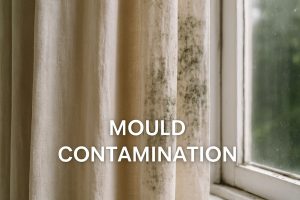 Curtains located in humid environments often accumulate microbial growth. Mould spores penetrate deeply into fibrous networks, binding with natural cellulose or protein residues. These microorganisms thrive in microclimates where the relative humidity exceeds 65%, particularly along window sills, in bathrooms, and in kitchens. They feed on organic residues—skin cells, airborne dust, or detergent remnants—creating colonies that can alter both colour and fibre integrity. Domestic detergents typically lack the enzymatic or solvent strength required to thoroughly neutralise these contaminants, and scrubbing can drive spores deeper into the weave, making the problem worse.
Curtains located in humid environments often accumulate microbial growth. Mould spores penetrate deeply into fibrous networks, binding with natural cellulose or protein residues. These microorganisms thrive in microclimates where the relative humidity exceeds 65%, particularly along window sills, in bathrooms, and in kitchens. They feed on organic residues—skin cells, airborne dust, or detergent remnants—creating colonies that can alter both colour and fibre integrity. Domestic detergents typically lack the enzymatic or solvent strength required to thoroughly neutralise these contaminants, and scrubbing can drive spores deeper into the weave, making the problem worse.
When mould establishes itself on fabrics, it initiates biochemical degradation. Fungal hyphae secrete cellulolytic and proteolytic enzymes, breaking down cellulose, silk fibroin, and other proteinaceous materials. This enzymatic action weakens fibres, causing brittleness, discolouration, and musty odours. In addition, metabolic by-products such as organic acids contribute to pH imbalance, leading to dye fading and hydrolytic fibre damage. Even when stains are visually removed, residual spores can remain dormant and reactivate in the presence of moisture and warmth.
Preventive Measures:
-
Maintain ambient humidity below 60% and ensure sufficient ventilation around window coverings.
For effective mould prevention, opt for Professional Curtain Cleaning in London to ensure thorough treatment of your curtains.
-
Spot-treat affected areas using acetic acid (vinegar) and sodium bicarbonate, altering surface pH to levels unfavourable to mould proliferation.
-
Incorporate ultrasonic or ozone cleaning for deep decontamination—ozone oxidises organic matter and destroys microbial DNA without harming fibres.
-
Ensure complete drying post-wash using low-humidity, temperature-controlled air circulation to prevent residual moisture pockets.
-
Utilise solvent-based antimicrobial treatments containing quaternary ammonium compounds or peracetic acid derivatives to eliminate embedded spores safely and permanently.
-
For sensitive textiles, consider periodic preventive sterilisation cycles under controlled ozone or UV-C light exposure.
At London Dry Cleaning Company, we employ advanced antimicrobial solvent technology that eradicates mould at the molecular level through selective oxidation and solvent-phase sterilisation. Our controlled process neutralises microbial colonies, restores pH balance, and prevents regrowth—all while preserving fibre strength, elasticity, and colour vibrancy. The result is a hygienic restoration that maintains both health standards and textile longevity.
Our professional curtain cleaning service in London not only targets mould but also restores the integrity of the fabric.
6. Photo-Degradation and Colour Fading
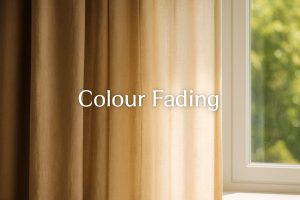 Ultraviolet (UV) radiation induces photochemical reactions that break down chromophoric structures within dye molecules, leading to their degradation. These reactions often involve photo-oxidation, where UV photons excite molecular bonds, leading to cleavage of conjugated systems responsible for colour. As these chemical bonds disintegrate, the dye’s capacity to absorb visible light decreases, producing a faded or washed-out appearance. The rate of degradation varies with dye class; azo, anthraquinone, and phthalocyanine dyes each exhibit distinct stability profiles under UV exposure.
Ultraviolet (UV) radiation induces photochemical reactions that break down chromophoric structures within dye molecules, leading to their degradation. These reactions often involve photo-oxidation, where UV photons excite molecular bonds, leading to cleavage of conjugated systems responsible for colour. As these chemical bonds disintegrate, the dye’s capacity to absorb visible light decreases, producing a faded or washed-out appearance. The rate of degradation varies with dye class; azo, anthraquinone, and phthalocyanine dyes each exhibit distinct stability profiles under UV exposure.
Prolonged sunlight not only alters the dye molecules but also degrades the fibre substrate. Natural fibres, such as cotton and silk, experience oxidation of cellulose and fibroin chains, respectively, while synthetic fibres, like polyester, may undergo surface embrittlement due to free radical formation. The combined effects of fibre and dye degradation lead to uneven fading, stiffness, and reduced tensile strength. Washing amplifies this process by removing the original finishing agents or optical brighteners that previously acted as UV shields, leaving the fabric more vulnerable to continued photo-degradation.
In addition, visible fading is exacerbated by scattering effects—when fibres lose surface smoothness, light reflectance increases, diminishing colour depth. High-energy wavelengths penetrate deeper into lighter shades, which explains why pale colours often degrade faster than darker ones.
Preventive Measures:
Utilising Professional Curtain Cleaning in London can enhance the longevity of your curtains against UV exposure.
-
Rotate curtains periodically to balance UV exposure and ensure even ageing of exposed surfaces.
-
Apply UV-protective coatings or use lined curtains to absorb or reflect harmful wavelengths before they reach the textile.
-
Employ window films or UV-filtering glass in rooms with intense sunlight exposure to mitigate cumulative radiation.
-
For affected textiles, consider dye restoration and re-fixing treatments under professional supervision to re-stabilise molecular chromophores.
-
Integrate antioxidant finishes that neutralise free radicals and extend colour life.
At London Dry Cleaning Company, our proprietary solvent formulations stabilise dyes and reduce optical fading through a two-step process: chemical inhibition of free radical formation and optical surface smoothing. This dual-action approach extends the chromatic life of high-value textiles, preserving both hue intensity and fabric resilience for years to come.
For optimal results, choose Professional Curtain Cleaning in London to protect against colour fading.
7. Fibre Degradation and Tearing
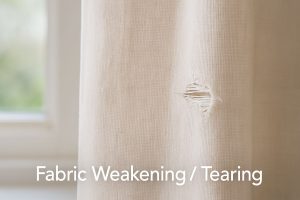 Chronic exposure to sunlight and environmental humidity leads to oxidation and hydrolytic cleavage in fibres, particularly in cotton, silk, and other natural materials. Over time, ultraviolet radiation causes the breakdown of cellulose and protein polymers through photo-oxidative reactions. In cotton, oxidation cleaves the glycosidic bonds in cellulose chains, decreasing the degree of polymerisation and reducing tensile strength. Silk, composed of fibroin proteins, undergoes peptide bond cleavage and oxidation of amino acid side chains, leading to brittleness and loss of elasticity.
Chronic exposure to sunlight and environmental humidity leads to oxidation and hydrolytic cleavage in fibres, particularly in cotton, silk, and other natural materials. Over time, ultraviolet radiation causes the breakdown of cellulose and protein polymers through photo-oxidative reactions. In cotton, oxidation cleaves the glycosidic bonds in cellulose chains, decreasing the degree of polymerisation and reducing tensile strength. Silk, composed of fibroin proteins, undergoes peptide bond cleavage and oxidation of amino acid side chains, leading to brittleness and loss of elasticity.
Humidity compounds these effects by introducing hydrolytic stress. When fibres repeatedly absorb and release moisture, hydrolysis of ester or amide linkages occurs, and internal strain accumulates at crystalline-amorphous interfaces. The result is a fibre matrix that becomes progressively weaker, more porous, and prone to rupture. In mixed-fibre fabrics, these processes act unevenly, creating mechanical imbalance across the weave that encourages tearing along seams or folds.
Pollutants such as nitrogen oxides, ozone, and particulate dust also accelerate degradation through catalytic oxidation and acid hydrolysis. Curtains exposed to open windows or urban air can suffer chemical ageing even when not directly exposed to sunlight. Combined with the mechanical agitation of domestic washing, these weakened zones often fail catastrophically, forming tears that extend rapidly along the warp or weft direction.
Preventive Measures:
-
Conduct pre-inspection using magnification or fibre tensile testing to identify degraded zones before washing.
-
Employ low-mechanical-action methods—such as gentle solvent immersion or ultrasonic cleaning—to minimise physical stress.
Consider Professional Curtain Cleaning in London to prevent fibre degradation and tearing.
-
Maintain temperature and pH neutrality during cleaning to avoid further hydrolysis or oxidation.
-
Integrate antioxidant and UV-inhibiting finishes to slow down future degradation.
-
Professional dry cleaning utilises precise agitation controls, temperature moderation, and solvent filtration systems to remove reactive residues and safeguard weakened fibres.
Our technicians evaluate tensile strength and apply reinforcement where necessary—standard practice in the conservation of vintage and designer drapery. Reinforcement may involve stabilising tears with fine mesh backings, microstitching weakened sections, or applying protective coatings designed to bond without altering fabric hand or appearance. This preservation-based approach ensures structural integrity while maintaining the curtain’s original aesthetic and historic value.
8. Risk Assessment: The Pitfalls of Domestic Washing
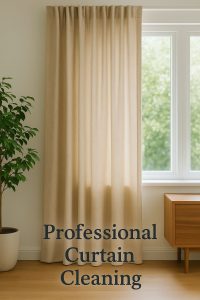 While home laundering offers convenience, its risks are often underestimated. Wet curtains exert a considerable mechanical load on washing drums, which can potentially damage both the fabric and the equipment. The mass of saturated fabric can exceed ten kilograms, stressing the machine’s suspension and bearings while subjecting certain seams to excessive tension. This combination leads to structural distortion and micro-tears that progressively weaken the material over multiple wash cycles.
While home laundering offers convenience, its risks are often underestimated. Wet curtains exert a considerable mechanical load on washing drums, which can potentially damage both the fabric and the equipment. The mass of saturated fabric can exceed ten kilograms, stressing the machine’s suspension and bearings while subjecting certain seams to excessive tension. This combination leads to structural distortion and micro-tears that progressively weaken the material over multiple wash cycles.
Extended drying indoors introduces further complications. When moisture remains trapped in dense folds, it creates a microenvironment ideal for microbial growth, mould formation, and unpleasant odours. Prolonged dampness also alters fabric hand, causing stiffness and uneven shrinkage. Alkaline detergents, commonly used in household products, can destabilise dyes and dissolve finishing agents, leading to patchy fading and loss of UV protection. Even so-called “delicate” settings on domestic machines fail to replicate the controlled solvent conditions necessary for safe fibre handling.
To avoid the pitfalls of domestic washing, always consider Professional Curtain Cleaning in London.
From a thermodynamic perspective, the drying process following aqueous washing subjects fibres to repeated expansion and contraction cycles. These cycles, combined with mechanical tension from gravity, cause residual deformation and permanent wrinkling. For lined or interlined curtains, the problem intensifies as differential shrinkage occurs between fabric layers, distorting hems and pleats.
Environmental factors also merit consideration. Domestic washing machines consume large volumes of water—often 50 to 70 litres per cycle—and rely on detergents that release phosphates and surfactants into wastewater. Improperly rinsed residues contribute to fibre stiffness, yellowing, and skin irritation. By contrast, solvent-based professional cleaning operates on closed-loop systems that recycle cleaning agents, drastically reducing both water and energy consumption.
From an economic and ecological standpoint, professional solvent cleaning represents a superior lifecycle strategy. It reduces water consumption, prevents waste from failed attempts, minimises fabric degradation, and extends usable lifespan. In doing so, it preserves not only the material and aesthetic value of the curtains but also aligns with sustainable textile care principles, reducing environmental impact and maintaining indoor air quality.
Professional Curtain Care: A Controlled Scientific Approach
At London Dry Cleaning Company, curtain cleaning is treated as a highly specialised textile-science operation grounded in principles of fibre chemistry, materials engineering, and applied physics. Every curtain type—whether natural, synthetic, or composite—is assessed through a diagnostic process that considers weave density, dye chemistry, and previous exposure to environmental stresses. Rather than following a generic formula, our system relies on a data-driven workflow that ensures reproducible and safe cleaning and restoration outcomes.
Our tailored approach to Professional Curtain Cleaning in London guarantees the best outcomes for all types of curtains.
Our workflow incorporates analytical assessment, fibre identification, and treatment customisation based on quantitative metrics such as fibre elongation, tensile recovery, and moisture regain. We use digital microscopes to observe microfractures and identify oxidation or mould traces invisible to the naked eye. Spectrophotometric analysis determines colour integrity and guides solvent choice, ensuring no dye bleeding or optical loss. Solvent selection is guided by polarity indices and Hansen solubility parameters, matching solvent strength precisely to the fibre’s molecular structure.
The procedural framework includes:
-
Microscopic inspection for structural or environmental damage, including pitting, fibrillation, or microbial activity.
-
Solvent selection optimised for fabric chemistry, ensuring compatibility with both dye and fibre polymers.
-
Precision steaming and re-shaping under controlled tension and humidity to correct dimensional distortions.
-
Protective finishing using polymeric coatings that restore lustre, drape, and resistance to further degradation.
-
Moisture and pH calibration ensure internal equilibrium and prevent long-term brittleness.
Additionally, our controlled-environment cleaning chambers maintain constant temperature and solvent purity. Each stage is recorded via process-tracking sensors that log solvent saturation, drying temperature, and mechanical torque. This traceability enables us to evaluate results scientifically, ensuring the integrity of each textile is preserved.
By choosing Professional Curtain Cleaning in London, you can be assured that our cleaning process meets rigorous standards.
This scientific yet artisanal approach bridges analytical precision and craftsmanship. It guarantees that every curtain retains not only its tactile softness and hue integrity but also its mechanical strength and form stability, embodying the fusion of laboratory science and professional artistry that defines our operation.
Case Studies
In one documented case, a client presented sheer voile curtains that had contracted by nearly ten centimetres following domestic laundering. The distortion stemmed from fibre relaxation shrinkage and residual detergent alkalinity, which had destabilised the polyester-cotton blend. We analysed the material using microscopic inspection to determine fibre strain patterns and identified mild hydrolytic stress at the seam edges. Through controlled solvent immersion, calibrated thermal relaxation, and a humidity-regulated tensioning process, we reinstated their original dimensions with no residual distortion. The process included stepwise thermal relaxation cycles, monitored through infrared thermography to ensure even expansion across the fabric plane.
Another instance involved vintage silk drapery exhibiting both oxidative fading and tensile weakness. Silk, being a protein fibre, had suffered peptide chain cleavage from UV and pollutant exposure, causing dullness and reduced elasticity. Using solvent-phase dye stabilisers and low-heat steam finishing under an oxygen-controlled environment, we restored elasticity, sheen, and chromatic depth—preserving the historical authenticity of the material. This treatment combined antioxidant neutralisation, solvent-based chromophore reinforcement, and structural rehydration of the fibroin protein chains, resulting in restored mechanical integrity and enhanced optical brilliance.
Invest in Professional Curtain Cleaning in London for expert care that preserves your curtains for years.
Conclusion
Curtain maintenance represents a multidisciplinary challenge that extends far beyond surface cleaning. It demands a profound comprehension of the physicochemical and mechanical behaviour of textiles under environmental and operational stress. Each fabric type responds differently to heat, solvents, and atmospheric conditions—understanding this interaction is crucial for preventing irreversible damage.
Professional dry cleaning unites the disciplines of polymer chemistry, materials science, and fabric engineering into a systematic and sustainable methodology. The process encompasses fibre diagnostics, solvent compatibility testing, and mechanical stress modelling to optimise results. It aims not only to cleanse but to rejuvenate, stabilise, and preserve textile function over extended lifecycles.
From a scientific standpoint, proper conservation-based maintenance strikes a balance between cleanliness and fibre longevity. By managing parameters such as pH, humidity, solvent polarity, and thermal exposure, professionals achieve what domestic methods cannot: restoration without compromise. The ecological dimension is equally vital; solvent recovery systems and low-energy drying protocols minimise environmental footprint while maintaining superior hygiene standards.
Entrusting your curtains to London Dry Cleaning Company ensures not just aesthetic renewal but also structural preservation grounded in science. Our approach combines analytical precision with artisanal expertise, extending the lifespan of fabric, maintaining chromatic depth, and preserving tactile quality. Superior textile maintenance is an act of conservation, where chemistry meets craftsmanship and sustainability meets elegance.
👉 Book your professional curtain cleaning now, where we specialise in Professional Curtain Cleaning in London.




No comment